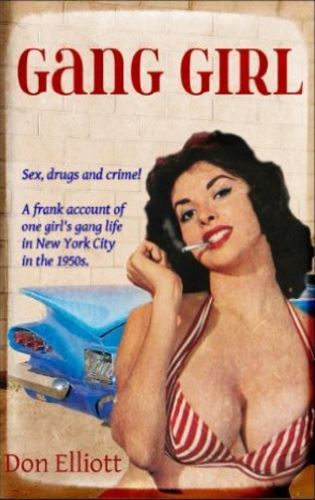

Originally published as Monarch # 248 in 1962, Canary’s Trailer Park Girls is a well-written caper story (or caper gone wrong story as so many of them are) combined with a sleaze-era nod toward the easy women of trailer parks (a popular theme of the era). There are six characters in the story and no one else matters at all. The three men are Burt Stone, Al Leeds, and Jack Cannon, all of who are sharing a trailer. The three women, Sally Talent, Marianne Nirvell, and Fran Novak also share a nearby trailer. Canary does an excellent job though of painting well-developed portraits of all six characters.
Stone, once was on his way to medical school, saving his inheritance, leaving cheaply so that the money would be there — until his brother nonchalantly stole his $10,000 inheritance and laughed and said go get a job. Having no choice, two weeks later, Stone enlisted and they re-enlisted again. On his very first leave, he went back to New York and clubbed his brother right in the mouth. Stone met Cannon and Leeds in the army. Stone now works as a bartender and is bitter. He figures he has ten thousand dollars coming to him and decided that, with his two buddies, he is going to rob a department store in Columbus, Ohio.
Cannon sold insurance “designed specifically to fit your personal needs now and in the future.” He was a big, overpowering man, proud of his body and his physical condition. He was one of the fortunate type who always seem to get just what they want by simply asking for it. His calendar started when he was fourteen an her name was Alice Rankin. He always got whoever he wanted by being direct and never treating the ones who said yes any differently than the ones who said no. Cannon was in on the robbery because it sounded like fun.
Leeds liked to race stock cars, rode a motorcycle, and reminded you of a tougher version of James Dean. “The only thing that kept Leeds from being strikingly handsome was that there was no compensating softness about him. He looked as if he ought to carry a gun and talk out of the side of his mouth.” Girls came easily to Leeds and he learned that girls came easily to hoods and therefore he thought he always knew the score. When his draft notice came, he didn’t want to go and listened when someone told him to eat soap before his physical so that the x-ray would show spots on his lungs, but that didn’t work. Stone and Cannon didn’t strike him as the type to pull a robbery. He thought of Cannon as a good-natured big cluck and Stone as someone who had something on his mind the whole time. One thing though he wasn’t going to spend the rest of his life selling televisions to middle-aged jerks.
They all viewed the trailer park as temporary, but did not like being looked down on as riff-raff.
The women too were all fully drawn in this novel. Sally was a junior at Ohio State and believed in love, but not in marriage. “Marriage was her mother and father. Love was naked woman, sitting up in bed, her hair around her shoulders.” He parents had both tramped around town and were not shy about it. Sally was bold and the first in her crowd to skinny-dip, sent to reformatory school, etc. “She didn’t bother much with men simply because she didn’t find many who excited her. She just wanted crowds and music and lights.”
Marianne was a nurse, a dedicated nurse, but as a teenager, a girl so beautiful that none of the guys would have the guts to ask her out. She would have liked to date them, but they never asked her.” She fell in love with an older man when she was seventeen. He was a college junior, planning to be a lawyer and a politician, blonde, and crew-cut, and they made love all summer till the usual happened and he forced her to get an abortion.
Each of these men ended up paired with one of these women as they are planning the heist of the local department store. The story is primarily about the men facing off against each other as they plan and the women getting involved. Canary writes well and the story flows well, perfectly paced, and full steam ahead toward its inevitable conclusion.








































